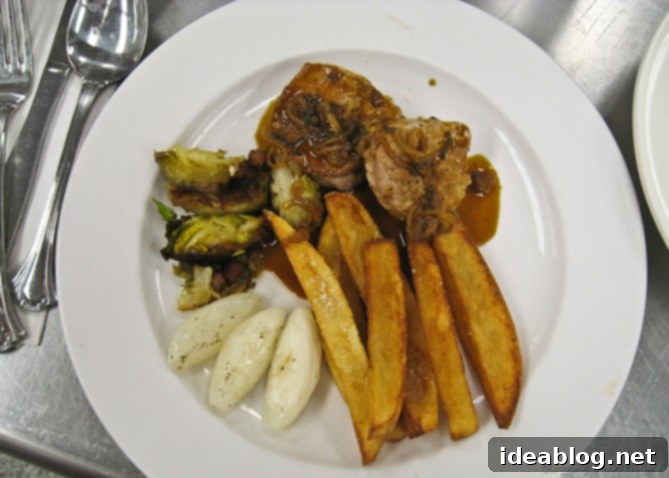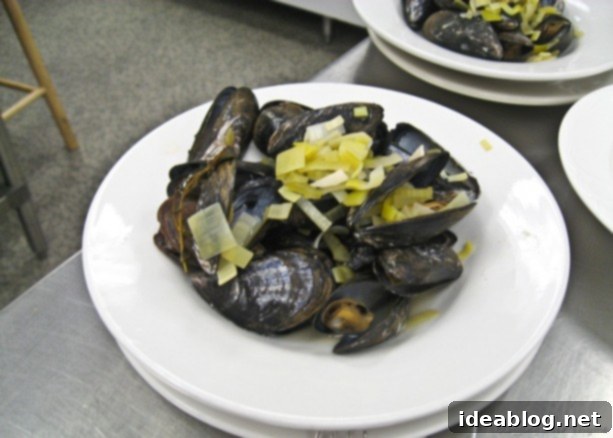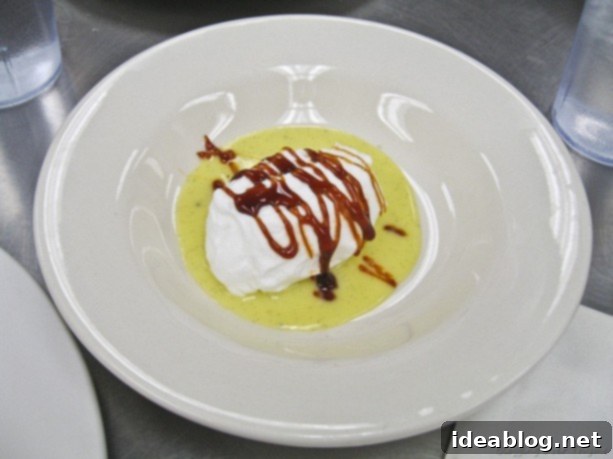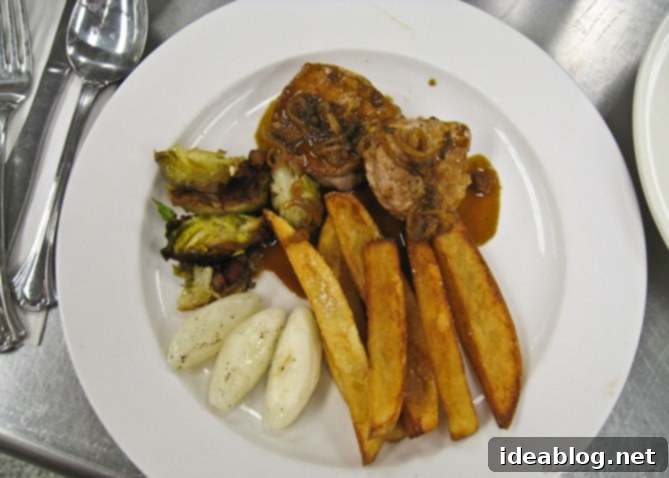Culinary School Chronicles: Mastering Complex Techniques and Challenging Menus
Having successfully navigated and officially survived my second practical exam, I am thrilled to be back to share an update on Wednesday’s intensive class! It was a day filled with demanding culinary tasks, pushing our skills to new limits. I must admit, in the rush of getting into the kitchen, I completely forgot to slip my camera into my pocket. Consequently, I don’t have any “in-process” photos to share, which is a minor disappointment, but rest assured, the day was nonetheless incredibly eventful and packed with valuable learning experiences.

A Demanding Daily Menu: The Reality of Professional Kitchens
Arriving on Wednesday, bright and early (though it was still completely pitch-black outside, a testament to our early start!), I harbored a quiet hope that the day’s menu might be a little lighter. My secret wish was for some breathing room, a chance to mentally prepare and rest before the looming practical exam scheduled for the following day. Nope! Guess again! The culinary gods, or rather, Chef Brian, had other plans.
Our daily menu was not only longer than usual but also intricately designed, featuring a multitude of components that needed to be executed à la minute – meaning, at the very last minute, just before service. This concept, as Chef Brian aptly explained in class, is a fundamental aspect of professional kitchens that we will become intimately familiar with as the weeks progress. It’s a crucial skill, demanding precision, timing, and an unwavering focus under pressure, truly reflecting the fast-paced environment of fine dining.
Exploring Seafood: Our First Mussels Preparation
Our culinary journey for the day began with an exciting introduction to seafood: mussels! This marked our very first time cooking mussels in school, a milestone for many of us. We embarked on a delightfully simple yet elegant preparation, focusing on highlighting the natural sweetness of the shellfish. The mussels were gently cooked with finely sliced leeks and celery, infused with the crisp notes of white wine. While the combination of leeks and white wine complemented the mussels beautifully, I wasn’t entirely convinced by the addition of celery in terms of personal preference. However, Chef assured us it’s a classic pairing, adding a subtle, refreshing crunch. Fortunately, this dish was relatively straightforward, requiring minimal attention and not an extensive amount of intricate preparation, serving as a gentle warm-up for the more complex challenges ahead.

The Main Event: Pan-Seared Pork Medallions with a Rich Jus
In stark contrast to the straightforward mussels, our main dish was an exercise in meticulous detail and layered flavors. We utilized some of the beautiful pork that we had expertly butchered in the previous day’s meat class. This was an excellent opportunity to apply our butchery skills directly to a finished plate, truly understanding the journey from raw ingredient to culinary masterpiece. The goal was to create perfectly pan-seared pork medallions, cooked to a tender, juicy perfection, and served alongside a deeply flavorful jus. This jus, a cornerstone of classical French cuisine, was meticulously crafted using roasted pork bones, aromatic mirepoix (carrots, celery, onions), fresh sage, and other carefully selected aromatics, all deglazed with white wine and enriched with veal stock. The slow reduction process extracted maximum flavor, resulting in a sauce that was both concentrated and incredibly satisfying.
Crafting the Pan Sauce and Accompaniments
Right before service, when timing becomes paramount, we swiftly prepared a quick pan sauce that would elevate the pork. This dynamic sauce began with sautéed shallots and garlic, building an aromatic base, before being deglazed with white wine. Fresh sage was added for its earthy aroma, followed by a dollop of Dijon mustard for a piquant kick, and a hint of apple cider vinegar to brighten the flavors. To this fragrant mixture, we added the strained, concentrated pork jus, allowing it to reduce significantly. This reduction process intensified the flavors, creating a glossy, rich sauce that beautifully complemented the savory pork.
To accompany our exquisite pork medallions, we prepared three distinct and equally challenging side dishes, each designed to showcase specific techniques and textures:
-
Glazed Turnips – The Art of Tournée
Our first side dish, Glazed Turnips, presented a significant technical challenge: we had to *tournée* them! Tournéeing is a classic French culinary technique involving shaping vegetables into uniform, seven-sided oval barrels. This was very difficult, not only because of the inherent precision required but also because the turnips we were using were a little spongy on the inside, making it incredibly challenging to achieve a clean, symmetrical shape. It demanded patience, a steady hand, and meticulous knife work. Once shaped, we cooked these delicate turnips using the etuvee method. This involved placing them in a saucepot with a small knob of butter, a pinch of salt, and a very, very minimal amount of water, then covering the pot with a cartouche (a parchment paper lid). The turnips were then allowed to cook gently over very low heat, essentially steaming in their own juices and butter until perfectly tender and subtly glazed. While simple in theory, the cumulative effort of tournéeing 15-20 turnips, each demanding individual attention, took considerably more time and effort than one might initially anticipate, teaching us the importance of consistency and dedication in repetitive kitchen tasks.
-
Steak Fries – Pomme Pont-Neuf
Next up were classic Steak Fries, known in French cuisine as “pomme Pont-Neuf.” This elegant name pays homage to the Pont Neuf, the oldest bridge in Paris, presumably for the fries’ substantial, rectangular shape. Achieving the perfect steak fry involves a two-stage cooking process. First, the uniformly cut potato batons are blanched in oil at a lower temperature, cooking them through and developing a creamy interior. Then, they are removed, allowed to cool slightly, and finally fried at a higher temperature just before service to achieve a beautifully golden, crispy exterior. The contrast between the fluffy interior and the crunchy crust is what makes these fries so utterly satisfying and a staple accompaniment in many upscale dishes.
-
Sautéed Brussels Sprouts with Bacon – A Flavorful Pairing
Our final side dish was Sautéed Brussels Sprouts with Bacon, a simple yet incredibly flavorful preparation. To ensure the sprouts cooked consistently and remained vibrant green, a crucial step was to par-cook them ahead of time. This involved scoring the bottom of each sprout with a small ‘X’, which helps them cook evenly and prevents the core from remaining tough while the outer leaves overcook. They were then par-cooked in vigorously boiling, heavily salted water – the salt not only seasons the sprouts from within but also helps to set their color and tenderize them quickly. Finally, just before service, these par-cooked sprouts were quickly sautéed with crispy bacon, adding a wonderful smoky, savory dimension that perfectly complemented their slightly bitter, earthy notes. This dish truly underscored how classic pairings and precise techniques can elevate even the simplest vegetables.
A Sweet Reprise: The Art of Floating Island
And for dessert, serving as an extra practice session for the demanding practical exam scheduled for the following day, we once again tried our hands at making floating island (île flottante)! This iconic French dessert, while seemingly ethereal and light, involves numerous components and demands meticulous plating at the very last minute to ensure its delicate structure and textures are perfectly presented. The creation of soft, billowy meringues, a silky crème anglaise, and a delicate caramel drizzle requires precision and timing. After this second attempt at making it, I felt significantly more confident in my ability to execute each element. Our caramel, perhaps a tad too dark, actually turned out to be a happy accident in my opinion, as its slightly deeper, more bitter notes provided a wonderful counterpoint, beautifully cutting through the sweetness of the meringue and crème anglaise. It was a perfect example of how sometimes, small imperfections can lead to delightful enhancements in flavor.

Preparing for What’s Next: Theory and Practical Exams
Our afternoon was then dedicated to an exhaustive review session, preparing us both mentally and practically for the next day’s crucial theory and practical exam. This dedicated time allowed us to consolidate the day’s learning, address any lingering questions, and refine our techniques for the upcoming assessment. The intensity of culinary school is relentless, with each day building upon the last, demanding constant attention to detail and a commitment to continuous improvement. I will, of course, tell you all about the exam itself and its results in an upcoming future post, so stay tuned for more insights into the challenging world of professional culinary training!
Happy Friday, and thank you for joining me on this culinary adventure!
